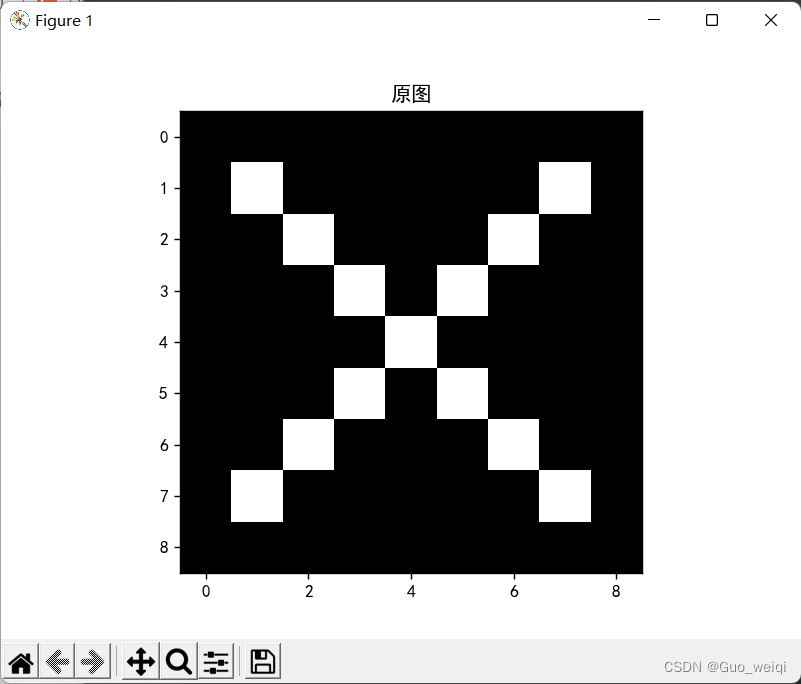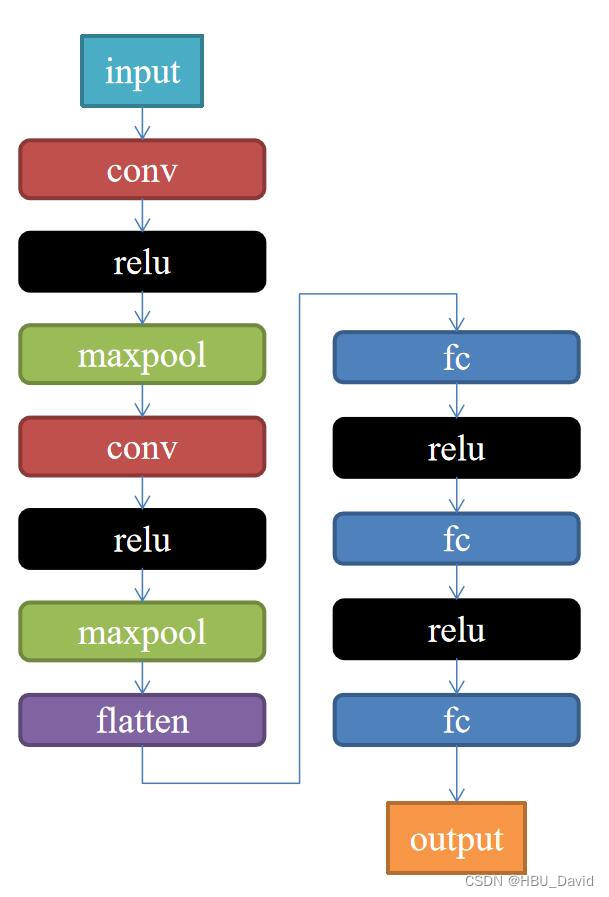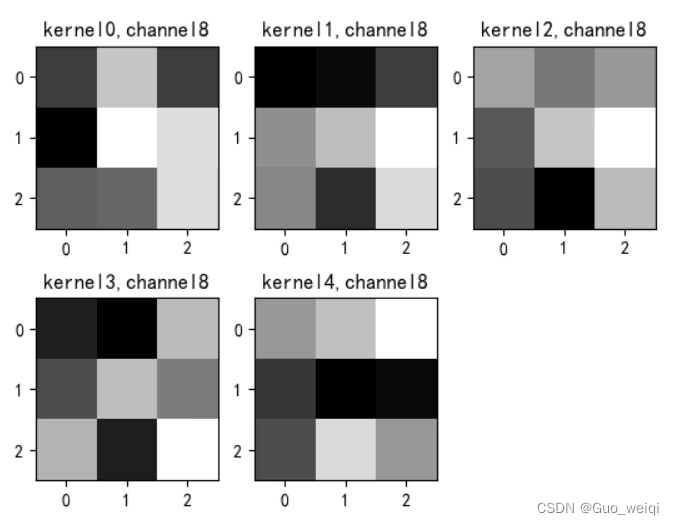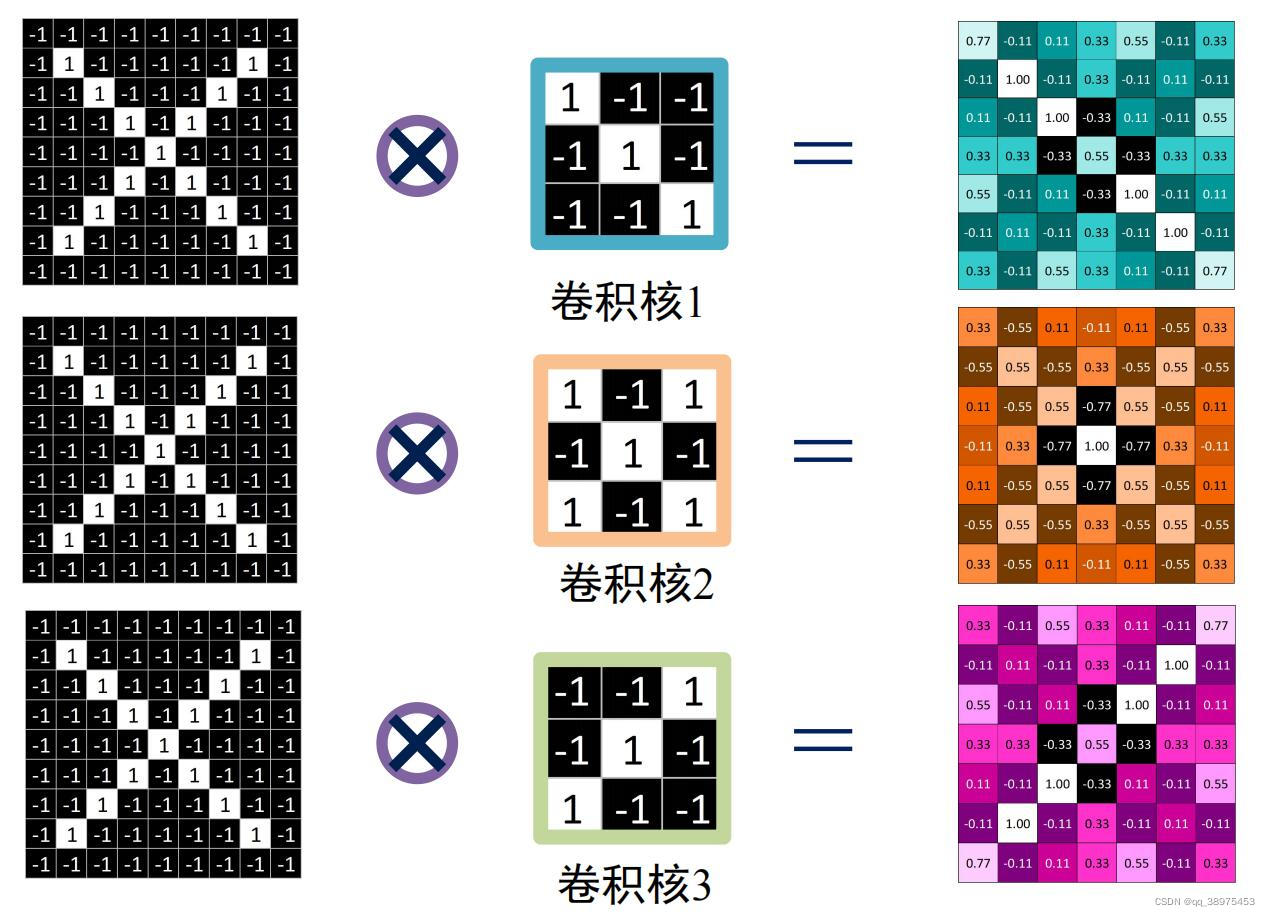一、实现卷积-池化-激活
1. Numpy版本:手工实现 卷积-池化-激活
自定义卷积算子、池化算子实现
import numpy as np
x = np.array([[-1, -1, -1, -1, -1, -1, -1, -1, -1],
[-1, 1, -1, -1, -1, -1, -1, 1, -1],
[-1, -1, 1, -1, -1, -1, 1, -1, -1],
[-1, -1, -1, 1, -1, 1, -1, -1, -1],
[-1, -1, -1, -1, 1, -1, -1, -1, -1],
[-1, -1, -1, 1, -1, 1, -1, -1, -1],
[-1, -1, 1, -1, -1, -1, 1, -1, -1],
[-1, 1, -1, -1, -1, -1, -1, 1, -1],
[-1, -1, -1, -1, -1, -1, -1, -1, -1]])
print("x=\n", x)
# 初始化 三个 卷积核
Kernel = [[0 for i in range(0, 3)] for j in range(0, 3)]
Kernel[0] = np.array([[1, -1, -1],
[-1, 1, -1],
[-1, -1, 1]])
Kernel[1] = np.array([[1, -1, 1],
[-1, 1, -1],
[1, -1, 1]])
Kernel[2] = np.array([[-1, -1, 1],
[-1, 1, -1],
[1, -1, -1]])
# --------------- 卷积 ---------------
stride = 1 # 步长
feature_map_h = 7 # 特征图的高
feature_map_w = 7 # 特征图的宽
feature_map = [0 for i in range(0, 3)] # 初始化3个特征图
for i in range(0, 3):
feature_map[i] = np.zeros((feature_map_h, feature_map_w)) # 初始化特征图
for h in range(feature_map_h): # 向下滑动,得到卷积后的固定行
for w in range(feature_map_w): # 向右滑动,得到卷积后的固定行的列
v_start = h * stride # 滑动窗口的起始行(高)
v_end = v_start + 3 # 滑动窗口的结束行(高)
h_start = w * stride # 滑动窗口的起始列(宽)
h_end = h_start + 3 # 滑动窗口的结束列(宽)
window = x[v_start:v_end, h_start:h_end] # 从图切出一个滑动窗口
for i in range(0, 3):
feature_map[i][h, w] = np.divide(np.sum(np.multiply(window, Kernel[i][:, :])), 9)
print("feature_map:\n", np.around(feature_map, decimals=2))
# --------------- 池化 ---------------
pooling_stride = 2 # 步长
pooling_h = 4 # 特征图的高
pooling_w = 4 # 特征图的宽
feature_map_pad_0 = [[0 for i in range(0, 8)] for j in range(0, 8)]
for i in range(0, 3): # 特征图 补 0 ,行 列 都要加 1 (因为上一层是奇数,池化窗口用的偶数)
feature_map_pad_0[i] = np.pad(feature_map[i], ((0, 1), (0, 1)), 'constant', constant_values=(0, 0))
# print("feature_map_pad_0 0:\n", np.around(feature_map_pad_0[0], decimals=2))
pooling = [0 for i in range(0, 3)]
for i in range(0, 3):
pooling[i] = np.zeros((pooling_h, pooling_w)) # 初始化特征图
for h in range(pooling_h): # 向下滑动,得到卷积后的固定行
for w in range(pooling_w): # 向右滑动,得到卷积后的固定行的列
v_start = h * pooling_stride # 滑动窗口的起始行(高)
v_end = v_start + 2 # 滑动窗口的结束行(高)
h_start = w * pooling_stride # 滑动窗口的起始列(宽)
h_end = h_start + 2 # 滑动窗口的结束列(宽)
for i in range(0, 3):
pooling[i][h, w] = np.max(feature_map_pad_0[i][v_start:v_end, h_start:h_end])
print("pooling:\n", np.around(pooling[0], decimals=2))
print("pooling:\n", np.around(pooling[1], decimals=2))
print("pooling:\n", np.around(pooling[2], decimals=2))
# --------------- 激活 ---------------
def relu(x):
return (abs(x) + x) / 2
relu_map_h = 7 # 特征图的高
relu_map_w = 7 # 特征图的宽
relu_map = [0 for i in range(0, 3)] # 初始化3个特征图
for i in range(0, 3):
relu_map[i] = np.zeros((relu_map_h, relu_map_w)) # 初始化特征图
for i in range(0, 3):
relu_map[i] = relu(feature_map[i])
print("relu map :\n", np.around(relu_map[0], decimals=2))
print("relu map :\n", np.around(relu_map[1], decimals=2))
print("relu map :\n", np.around(relu_map[2], decimals=2))x=
[[-1 -1 -1 -1 -1 -1 -1 -1 -1]
[-1 1 -1 -1 -1 -1 -1 1 -1]
[-1 -1 1 -1 -1 -1 1 -1 -1]
[-1 -1 -1 1 -1 1 -1 -1 -1]
[-1 -1 -1 -1 1 -1 -1 -1 -1]
[-1 -1 -1 1 -1 1 -1 -1 -1]
[-1 -1 1 -1 -1 -1 1 -1 -1]
[-1 1 -1 -1 -1 -1 -1 1 -1]
[-1 -1 -1 -1 -1 -1 -1 -1 -1]]
feature_map:
[[[ 0.78 -0.11 0.11 0.33 0.56 -0.11 0.33]
[-0.11 1. -0.11 0.33 -0.11 0.11 -0.11]
[ 0.11 -0.11 1. -0.33 0.11 -0.11 0.56]
[ 0.33 0.33 -0.33 0.56 -0.33 0.33 0.33]
[ 0.56 -0.11 0.11 -0.33 1. -0.11 0.11]
[-0.11 0.11 -0.11 0.33 -0.11 1. -0.11]
[ 0.33 -0.11 0.56 0.33 0.11 -0.11 0.78]]
[[ 0.33 -0.56 0.11 -0.11 0.11 -0.56 0.33]
[-0.56 0.56 -0.56 0.33 -0.56 0.56 -0.56]
[ 0.11 -0.56 0.56 -0.78 0.56 -0.56 0.11]
[-0.11 0.33 -0.78 1. -0.78 0.33 -0.11]
[ 0.11 -0.56 0.56 -0.78 0.56 -0.56 0.11]
[-0.56 0.56 -0.56 0.33 -0.56 0.56 -0.56]
[ 0.33 -0.56 0.11 -0.11 0.11 -0.56 0.33]]
[[ 0.33 -0.11 0.56 0.33 0.11 -0.11 0.78]
[-0.11 0.11 -0.11 0.33 -0.11 1. -0.11]
[ 0.56 -0.11 0.11 -0.33 1. -0.11 0.11]
[ 0.33 0.33 -0.33 0.56 -0.33 0.33 0.33]
[ 0.11 -0.11 1. -0.33 0.11 -0.11 0.56]
[-0.11 1. -0.11 0.33 -0.11 0.11 -0.11]
[ 0.78 -0.11 0.11 0.33 0.56 -0.11 0.33]]]
pooling:
[[1. 0.33 0.56 0.33]
[0.33 1. 0.33 0.56]
[0.56 0.33 1. 0.11]
[0.33 0.56 0.11 0.78]]
pooling:
[[0.56 0.33 0.56 0.33]
[0.33 1. 0.56 0.11]
[0.56 0.56 0.56 0.11]
[0.33 0.11 0.11 0.33]]
pooling:
[[0.33 0.56 1. 0.78]
[0.56 0.56 1. 0.33]
[1. 1. 0.11 0.56]
[0.78 0.33 0.56 0.33]]
relu map :
[[0.78 0. 0.11 0.33 0.56 0. 0.33]
[0. 1. 0. 0.33 0. 0.11 0. ]
[0.11 0. 1. 0. 0.11 0. 0.56]
[0.33 0.33 0. 0.56 0. 0.33 0.33]
[0.56 0. 0.11 0. 1. 0. 0.11]
[0. 0.11 0. 0.33 0. 1. 0. ]
[0.33 0. 0.56 0.33 0.11 0. 0.78]]
relu map :
[[0.33 0. 0.11 0. 0.11 0. 0.33]
[0. 0.56 0. 0.33 0. 0.56 0. ]
[0.11 0. 0.56 0. 0.56 0. 0.11]
[0. 0.33 0. 1. 0. 0.33 0. ]
[0.11 0. 0.56 0. 0.56 0. 0.11]
[0. 0.56 0. 0.33 0. 0.56 0. ]
[0.33 0. 0.11 0. 0.11 0. 0.33]]
relu map :
[[0.33 0. 0.56 0.33 0.11 0. 0.78]
[0. 0.11 0. 0.33 0. 1. 0. ]
[0.56 0. 0.11 0. 1. 0. 0.11]
[0.33 0.33 0. 0.56 0. 0.33 0.33]
[0.11 0. 1. 0. 0.11 0. 0.56]
[0. 1. 0. 0.33 0. 0.11 0. ]
[0.78 0. 0.11 0.33 0.56 0. 0.33]]2. Pytorch版本:调用函数实现 卷积-池化-激活
调用框架自带算子实现,对比自定义算子
import numpy as np
import torch
import torch.nn as nn
x = torch.tensor([[[[-1, -1, -1, -1, -1, -1, -1, -1, -1],
[-1, 1, -1, -1, -1, -1, -1, 1, -1],
[-1, -1, 1, -1, -1, -1, 1, -1, -1],
[-1, -1, -1, 1, -1, 1, -1, -1, -1],
[-1, -1, -1, -1, 1, -1, -1, -1, -1],
[-1, -1, -1, 1, -1, 1, -1, -1, -1],
[-1, -1, 1, -1, -1, -1, 1, -1, -1],
[-1, 1, -1, -1, -1, -1, -1, 1, -1],
[-1, -1, -1, -1, -1, -1, -1, -1, -1]]]], dtype=torch.float)
print(x.shape)
print(x)
print("--------------- 卷积 ---------------")
conv1 = nn.Conv2d(1, 1, (3, 3), 1) # in_channel , out_channel , kennel_size , stride
conv1.weight.data = torch.Tensor([[[[1, -1, -1],
[-1, 1, -1],
[-1, -1, 1]]
]])
conv2 = nn.Conv2d(1, 1, (3, 3), 1) # in_channel , out_channel , kennel_size , stride
conv2.weight.data = torch.Tensor([[[[1, -1, 1],
[-1, 1, -1],
[1, -1, 1]]
]])
conv3 = nn.Conv2d(1, 1, (3, 3), 1) # in_channel , out_channel , kennel_size , stride
conv3.weight.data = torch.Tensor([[[[-1, -1, 1],
[-1, 1, -1],
[1, -1, -1]]
]])
feature_map1 = conv1(x)
feature_map2 = conv2(x)
feature_map3 = conv3(x)
print(feature_map1 / 9)
print(feature_map2 / 9)
print(feature_map3 / 9)
print("--------------- 池化 ---------------")
max_pool = nn.MaxPool2d(2, padding=0, stride=2) # Pooling
zeroPad = nn.ZeroPad2d(padding=(0, 1, 0, 1)) # pad 0 , Left Right Up Down
feature_map_pad_0_1 = zeroPad(feature_map1)
feature_pool_1 = max_pool(feature_map_pad_0_1)
feature_map_pad_0_2 = zeroPad(feature_map2)
feature_pool_2 = max_pool(feature_map_pad_0_2)
feature_map_pad_0_3 = zeroPad(feature_map3)
feature_pool_3 = max_pool(feature_map_pad_0_3)
print(feature_pool_1.size())
print(feature_pool_1 / 9)
print(feature_pool_2 / 9)
print(feature_pool_3 / 9)
print("--------------- 激活 ---------------")
activation_function = nn.ReLU()
feature_relu1 = activation_function(feature_map1)
feature_relu2 = activation_function(feature_map2)
feature_relu3 = activation_function(feature_map3)
print(feature_relu1 / 9)
print(feature_relu2 / 9)
print(feature_relu3 / 9)torch.Size([1, 1, 9, 9])
tensor([[[[-1., -1., -1., -1., -1., -1., -1., -1., -1.],
[-1., 1., -1., -1., -1., -1., -1., 1., -1.],
[-1., -1., 1., -1., -1., -1., 1., -1., -1.],
[-1., -1., -1., 1., -1., 1., -1., -1., -1.],
[-1., -1., -1., -1., 1., -1., -1., -1., -1.],
[-1., -1., -1., 1., -1., 1., -1., -1., -1.],
[-1., -1., 1., -1., -1., -1., 1., -1., -1.],
[-1., 1., -1., -1., -1., -1., -1., 1., -1.],
[-1., -1., -1., -1., -1., -1., -1., -1., -1.]]]])
--------------- 卷积 ---------------
tensor([[[[ 0.7645, -0.1243, 0.0979, 0.3201, 0.5423, -0.1243, 0.3201],
[-0.1243, 0.9868, -0.1243, 0.3201, -0.1243, 0.0979, -0.1243],
[ 0.0979, -0.1243, 0.9868, -0.3466, 0.0979, -0.1243, 0.5423],
[ 0.3201, 0.3201, -0.3466, 0.5423, -0.3466, 0.3201, 0.3201],
[ 0.5423, -0.1243, 0.0979, -0.3466, 0.9868, -0.1243, 0.0979],
[-0.1243, 0.0979, -0.1243, 0.3201, -0.1243, 0.9868, -0.1243],
[ 0.3201, -0.1243, 0.5423, 0.3201, 0.0979, -0.1243, 0.7645]]]],
grad_fn=<DivBackward0>)
tensor([[[[ 0.3503, -0.5385, 0.1281, -0.0941, 0.1281, -0.5385, 0.3503],
[-0.5385, 0.5726, -0.5385, 0.3503, -0.5385, 0.5726, -0.5385],
[ 0.1281, -0.5385, 0.5726, -0.7608, 0.5726, -0.5385, 0.1281],
[-0.0941, 0.3503, -0.7608, 1.0170, -0.7608, 0.3503, -0.0941],
[ 0.1281, -0.5385, 0.5726, -0.7608, 0.5726, -0.5385, 0.1281],
[-0.5385, 0.5726, -0.5385, 0.3503, -0.5385, 0.5726, -0.5385],
[ 0.3503, -0.5385, 0.1281, -0.0941, 0.1281, -0.5385, 0.3503]]]],
grad_fn=<DivBackward0>)
tensor([[[[ 0.3157, -0.1288, 0.5379, 0.3157, 0.0934, -0.1288, 0.7601],
[-0.1288, 0.0934, -0.1288, 0.3157, -0.1288, 0.9823, -0.1288],
[ 0.5379, -0.1288, 0.0934, -0.3510, 0.9823, -0.1288, 0.0934],
[ 0.3157, 0.3157, -0.3510, 0.5379, -0.3510, 0.3157, 0.3157],
[ 0.0934, -0.1288, 0.9823, -0.3510, 0.0934, -0.1288, 0.5379],
[-0.1288, 0.9823, -0.1288, 0.3157, -0.1288, 0.0934, -0.1288],
[ 0.7601, -0.1288, 0.0934, 0.3157, 0.5379, -0.1288, 0.3157]]]],
grad_fn=<DivBackward0>)
--------------- 池化 ---------------
torch.Size([1, 1, 4, 4])
tensor([[[[0.9868, 0.3201, 0.5423, 0.3201],
[0.3201, 0.9868, 0.3201, 0.5423],
[0.5423, 0.3201, 0.9868, 0.0979],
[0.3201, 0.5423, 0.0979, 0.7645]]]], grad_fn=<DivBackward0>)
tensor([[[[0.5726, 0.3503, 0.5726, 0.3503],
[0.3503, 1.0170, 0.5726, 0.1281],
[0.5726, 0.5726, 0.5726, 0.1281],
[0.3503, 0.1281, 0.1281, 0.3503]]]], grad_fn=<DivBackward0>)
tensor([[[[0.3157, 0.5379, 0.9823, 0.7601],
[0.5379, 0.5379, 0.9823, 0.3157],
[0.9823, 0.9823, 0.0934, 0.5379],
[0.7601, 0.3157, 0.5379, 0.3157]]]], grad_fn=<DivBackward0>)
--------------- 激活 ---------------
tensor([[[[0.7645, 0.0000, 0.0979, 0.3201, 0.5423, 0.0000, 0.3201],
[0.0000, 0.9868, 0.0000, 0.3201, 0.0000, 0.0979, 0.0000],
[0.0979, 0.0000, 0.9868, 0.0000, 0.0979, 0.0000, 0.5423],
[0.3201, 0.3201, 0.0000, 0.5423, 0.0000, 0.3201, 0.3201],
[0.5423, 0.0000, 0.0979, 0.0000, 0.9868, 0.0000, 0.0979],
[0.0000, 0.0979, 0.0000, 0.3201, 0.0000, 0.9868, 0.0000],
[0.3201, 0.0000, 0.5423, 0.3201, 0.0979, 0.0000, 0.7645]]]],
grad_fn=<DivBackward0>)
tensor([[[[0.3503, 0.0000, 0.1281, 0.0000, 0.1281, 0.0000, 0.3503],
[0.0000, 0.5726, 0.0000, 0.3503, 0.0000, 0.5726, 0.0000],
[0.1281, 0.0000, 0.5726, 0.0000, 0.5726, 0.0000, 0.1281],
[0.0000, 0.3503, 0.0000, 1.0170, 0.0000, 0.3503, 0.0000],
[0.1281, 0.0000, 0.5726, 0.0000, 0.5726, 0.0000, 0.1281],
[0.0000, 0.5726, 0.0000, 0.3503, 0.0000, 0.5726, 0.0000],
[0.3503, 0.0000, 0.1281, 0.0000, 0.1281, 0.0000, 0.3503]]]],
grad_fn=<DivBackward0>)
tensor([[[[0.3157, 0.0000, 0.5379, 0.3157, 0.0934, 0.0000, 0.7601],
[0.0000, 0.0934, 0.0000, 0.3157, 0.0000, 0.9823, 0.0000],
[0.5379, 0.0000, 0.0934, 0.0000, 0.9823, 0.0000, 0.0934],
[0.3157, 0.3157, 0.0000, 0.5379, 0.0000, 0.3157, 0.3157],
[0.0934, 0.0000, 0.9823, 0.0000, 0.0934, 0.0000, 0.5379],
[0.0000, 0.9823, 0.0000, 0.3157, 0.0000, 0.0934, 0.0000],
[0.7601, 0.0000, 0.0934, 0.3157, 0.5379, 0.0000, 0.3157]]]],
grad_fn=<DivBackward0>)
3. 可视化:了解数字与图像之间的关系
可视化卷积核和特征图
import torch
import torch.nn as nn
import matplotlib.pyplot as plt
import os
os.environ["KMP_DUPLICATE_LIB_OK"] = "TRUE"
plt.rcParams['font.sans-serif'] = ['SimHei'] # 用来正常显示中文标签
plt.rcParams['axes.unicode_minus'] = False # 用来正常显示负号 #有中文出现的情况,需要u'内容
x = torch.tensor([[[[-1, -1, -1, -1, -1, -1, -1, -1, -1],
[-1, 1, -1, -1, -1, -1, -1, 1, -1],
[-1, -1, 1, -1, -1, -1, 1, -1, -1],
[-1, -1, -1, 1, -1, 1, -1, -1, -1],
[-1, -1, -1, -1, 1, -1, -1, -1, -1],
[-1, -1, -1, 1, -1, 1, -1, -1, -1],
[-1, -1, 1, -1, -1, -1, 1, -1, -1],
[-1, 1, -1, -1, -1, -1, -1, 1, -1],
[-1, -1, -1, -1, -1, -1, -1, -1, -1]]]], dtype=torch.float)
print(x.shape)
print(x)
img = x.data.squeeze().numpy() # 将输出转换为图片的格式
plt.imshow(img, cmap='gray')
plt.title('原图')
plt.show()
print("--------------- 卷积 ---------------")
conv1 = nn.Conv2d(1, 1, (3, 3), 1) # in_channel , out_channel , kennel_size , stride
conv1.weight.data = torch.Tensor([[[[1, -1, -1],
[-1, 1, -1],
[-1, -1, 1]]
]])
img = conv1.weight.data.squeeze().numpy() # 将输出转换为图片的格式
plt.imshow(img, cmap='gray')
plt.title('Kernel 1')
plt.show()
conv2 = nn.Conv2d(1, 1, (3, 3), 1) # in_channel , out_channel , kennel_size , stride
conv2.weight.data = torch.Tensor([[[[1, -1, 1],
[-1, 1, -1],
[1, -1, 1]]
]])
img = conv2.weight.data.squeeze().numpy() # 将输出转换为图片的格式
plt.imshow(img, cmap='gray')
plt.title('Kernel 2')
plt.show()
conv3 = nn.Conv2d(1, 1, (3, 3), 1) # in_channel , out_channel , kennel_size , stride
conv3.weight.data = torch.Tensor([[[[-1, -1, 1],
[-1, 1, -1],
[1, -1, -1]]
]])
img = conv3.weight.data.squeeze().numpy() # 将输出转换为图片的格式
plt.imshow(img, cmap='gray')
plt.title('Kernel 3')
plt.show()
feature_map1 = conv1(x)
feature_map2 = conv2(x)
feature_map3 = conv3(x)
print(feature_map1 / 9)
print(feature_map2 / 9)
print(feature_map3 / 9)
img = feature_map1.data.squeeze().numpy() # 将输出转换为图片的格式
plt.imshow(img, cmap='gray')
plt.title('卷积后的特征图1')
plt.show()
print("--------------- 池化 ---------------")
max_pool = nn.MaxPool2d(2, padding=0, stride=2) # Pooling
zeroPad = nn.ZeroPad2d(padding=(0, 1, 0, 1)) # pad 0 , Left Right Up Down
feature_map_pad_0_1 = zeroPad(feature_map1)
feature_pool_1 = max_pool(feature_map_pad_0_1)
feature_map_pad_0_2 = zeroPad(feature_map2)
feature_pool_2 = max_pool(feature_map_pad_0_2)
feature_map_pad_0_3 = zeroPad(feature_map3)
feature_pool_3 = max_pool(feature_map_pad_0_3)
print(feature_pool_1.size())
print(feature_pool_1 / 9)
print(feature_pool_2 / 9)
print(feature_pool_3 / 9)
img = feature_pool_1.data.squeeze().numpy() # 将输出转换为图片的格式
plt.imshow(img, cmap='gray')
plt.title('卷积池化后的特征图1')
plt.show()
print("--------------- 激活 ---------------")
activation_function = nn.ReLU()
feature_relu1 = activation_function(feature_map1)
feature_relu2 = activation_function(feature_map2)
feature_relu3 = activation_function(feature_map3)
print(feature_relu1 / 9)
print(feature_relu2 / 9)
print(feature_relu3 / 9)
img = feature_relu1.data.squeeze().numpy() # 将输出转换为图片的格式
plt.imshow(img, cmap='gray')
plt.title('卷积 + relu 后的特征图1')
plt.show()torch.Size([1, 1, 9, 9])
tensor([[[[-1., -1., -1., -1., -1., -1., -1., -1., -1.],
[-1., 1., -1., -1., -1., -1., -1., 1., -1.],
[-1., -1., 1., -1., -1., -1., 1., -1., -1.],
[-1., -1., -1., 1., -1., 1., -1., -1., -1.],
[-1., -1., -1., -1., 1., -1., -1., -1., -1.],
[-1., -1., -1., 1., -1., 1., -1., -1., -1.],
[-1., -1., 1., -1., -1., -1., 1., -1., -1.],
[-1., 1., -1., -1., -1., -1., -1., 1., -1.],
[-1., -1., -1., -1., -1., -1., -1., -1., -1.]]]])
--------------- 卷积 ---------------
tensor([[[[ 0.8130, -0.0759, 0.1463, 0.3685, 0.5908, -0.0759, 0.3685],
[-0.0759, 1.0352, -0.0759, 0.3685, -0.0759, 0.1463, -0.0759],
[ 0.1463, -0.0759, 1.0352, -0.2981, 0.1463, -0.0759, 0.5908],
[ 0.3685, 0.3685, -0.2981, 0.5908, -0.2981, 0.3685, 0.3685],
[ 0.5908, -0.0759, 0.1463, -0.2981, 1.0352, -0.0759, 0.1463],
[-0.0759, 0.1463, -0.0759, 0.3685, -0.0759, 1.0352, -0.0759],
[ 0.3685, -0.0759, 0.5908, 0.3685, 0.1463, -0.0759, 0.8130]]]],
grad_fn=<DivBackward0>)
tensor([[[[ 0.3294, -0.5595, 0.1071, -0.1151, 0.1071, -0.5595, 0.3294],
[-0.5595, 0.5516, -0.5595, 0.3294, -0.5595, 0.5516, -0.5595],
[ 0.1071, -0.5595, 0.5516, -0.7818, 0.5516, -0.5595, 0.1071],
[-0.1151, 0.3294, -0.7818, 0.9960, -0.7818, 0.3294, -0.1151],
[ 0.1071, -0.5595, 0.5516, -0.7818, 0.5516, -0.5595, 0.1071],
[-0.5595, 0.5516, -0.5595, 0.3294, -0.5595, 0.5516, -0.5595],
[ 0.3294, -0.5595, 0.1071, -0.1151, 0.1071, -0.5595, 0.3294]]]],
grad_fn=<DivBackward0>)
tensor([[[[ 0.3348, -0.1096, 0.5571, 0.3348, 0.1126, -0.1096, 0.7793],
[-0.1096, 0.1126, -0.1096, 0.3348, -0.1096, 1.0015, -0.1096],
[ 0.5571, -0.1096, 0.1126, -0.3318, 1.0015, -0.1096, 0.1126],
[ 0.3348, 0.3348, -0.3318, 0.5571, -0.3318, 0.3348, 0.3348],
[ 0.1126, -0.1096, 1.0015, -0.3318, 0.1126, -0.1096, 0.5571],
[-0.1096, 1.0015, -0.1096, 0.3348, -0.1096, 0.1126, -0.1096],
[ 0.7793, -0.1096, 0.1126, 0.3348, 0.5571, -0.1096, 0.3348]]]],
grad_fn=<DivBackward0>)
--------------- 池化 ---------------
torch.Size([1, 1, 4, 4])
tensor([[[[1.0352, 0.3685, 0.5908, 0.3685],
[0.3685, 1.0352, 0.3685, 0.5908],
[0.5908, 0.3685, 1.0352, 0.1463],
[0.3685, 0.5908, 0.1463, 0.8130]]]], grad_fn=<DivBackward0>)
tensor([[[[0.5516, 0.3294, 0.5516, 0.3294],
[0.3294, 0.9960, 0.5516, 0.1071],
[0.5516, 0.5516, 0.5516, 0.1071],
[0.3294, 0.1071, 0.1071, 0.3294]]]], grad_fn=<DivBackward0>)
tensor([[[[0.3348, 0.5571, 1.0015, 0.7793],
[0.5571, 0.5571, 1.0015, 0.3348],
[1.0015, 1.0015, 0.1126, 0.5571],
[0.7793, 0.3348, 0.5571, 0.3348]]]], grad_fn=<DivBackward0>)
--------------- 激活 ---------------
tensor([[[[0.8130, 0.0000, 0.1463, 0.3685, 0.5908, 0.0000, 0.3685],
[0.0000, 1.0352, 0.0000, 0.3685, 0.0000, 0.1463, 0.0000],
[0.1463, 0.0000, 1.0352, 0.0000, 0.1463, 0.0000, 0.5908],
[0.3685, 0.3685, 0.0000, 0.5908, 0.0000, 0.3685, 0.3685],
[0.5908, 0.0000, 0.1463, 0.0000, 1.0352, 0.0000, 0.1463],
[0.0000, 0.1463, 0.0000, 0.3685, 0.0000, 1.0352, 0.0000],
[0.3685, 0.0000, 0.5908, 0.3685, 0.1463, 0.0000, 0.8130]]]],
grad_fn=<DivBackward0>)
tensor([[[[0.3294, 0.0000, 0.1071, 0.0000, 0.1071, 0.0000, 0.3294],
[0.0000, 0.5516, 0.0000, 0.3294, 0.0000, 0.5516, 0.0000],
[0.1071, 0.0000, 0.5516, 0.0000, 0.5516, 0.0000, 0.1071],
[0.0000, 0.3294, 0.0000, 0.9960, 0.0000, 0.3294, 0.0000],
[0.1071, 0.0000, 0.5516, 0.0000, 0.5516, 0.0000, 0.1071],
[0.0000, 0.5516, 0.0000, 0.3294, 0.0000, 0.5516, 0.0000],
[0.3294, 0.0000, 0.1071, 0.0000, 0.1071, 0.0000, 0.3294]]]],
grad_fn=<DivBackward0>)
tensor([[[[0.3348, 0.0000, 0.5571, 0.3348, 0.1126, 0.0000, 0.7793],
[0.0000, 0.1126, 0.0000, 0.3348, 0.0000, 1.0015, 0.0000],
[0.5571, 0.0000, 0.1126, 0.0000, 1.0015, 0.0000, 0.1126],
[0.3348, 0.3348, 0.0000, 0.5571, 0.0000, 0.3348, 0.3348],
[0.1126, 0.0000, 1.0015, 0.0000, 0.1126, 0.0000, 0.5571],
[0.0000, 1.0015, 0.0000, 0.3348, 0.0000, 0.1126, 0.0000],
[0.7793, 0.0000, 0.1126, 0.3348, 0.5571, 0.0000, 0.3348]]]],
grad_fn=<DivBackward0>)






二、 基于CNN的XO识别
1. 数据集
2. 构建模型

import torch
from torchvision import transforms, datasets
import torch.nn as nn
from torch.utils.data import DataLoader
# 模型类
class Net(nn.Module):
def __init__(self):
super(Net, self).__init__()
self.conv1 = nn.Conv2d(1, 9, 3)
self.maxpool = nn.MaxPool2d(2, 2)
self.conv2 = nn.Conv2d(9, 5, 3)
self.relu = nn.ReLU()
self.fc1 = nn.Linear(27 * 27 * 5, 1200)
self.fc2 = nn.Linear(1200, 64)
self.fc3 = nn.Linear(64, 2)
def forward(self, x):
x = self.maxpool(self.relu(self.conv1(x)))
x = self.maxpool(self.relu(self.conv2(x)))
x = x.view(-1, 27 * 27 * 5)
x = self.relu(self.fc1(x))
x = self.relu(self.fc2(x))
x = self.fc3(x)
return x
model = Net()
print(model)
criterion = torch.nn.CrossEntropyLoss() # 损失函数 交叉熵损失函数
optimizer = torch.optim.SGD(model.parameters(), lr=0.1) # 优化函数:随机梯度下降
transforms = transforms.Compose([
transforms.ToTensor(), # 把图片进行归一化,并把数据转换成Tensor类型
transforms.Grayscale(1) # 把图片 转为灰度图
])
path = r'training_data_sm'
data_train = datasets.ImageFolder(path, transform=transforms)
data_loader = DataLoader(data_train, batch_size=64, shuffle=True)
epochs = 10
for epoch in range(epochs):
running_loss = 0.0
for i, data in enumerate(data_loader):
images, label = data
out = model(images)
loss = criterion(out, label)
optimizer.zero_grad()
loss.backward()
optimizer.step()
running_loss += loss.item()
if (i + 1) % 10 == 0:
print('[%d %5d] loss: %.3f' % (epoch + 1, i + 1, running_loss / 100))
running_loss = 0.0
print('finished train')
# 保存模型
torch.save(model.state_dict(), 'model_name.pth') # 保存的是模型, 不止是w和b权重值构建的神经网络模型:
Net(
(conv1): Conv2d(1, 9, kernel_size=(3, 3), stride=(1, 1))
(maxpool): MaxPool2d(kernel_size=2, stride=2, padding=0, dilation=1, ceil_mode=False)
(conv2): Conv2d(9, 5, kernel_size=(3, 3), stride=(1, 1))
(relu): ReLU()
(fc1): Linear(in_features=3645, out_features=1200, bias=True)
(fc2): Linear(in_features=1200, out_features=64, bias=True)
(fc3): Linear(in_features=64, out_features=2, bias=True)
)
损失函数输出:
[1 10] loss: 0.069
[1 20] loss: 0.069
[2 10] loss: 0.068
[2 20] loss: 0.067
[3 10] loss: 0.058
[3 20] loss: 0.045
[4 10] loss: 0.020
[4 20] loss: 0.008
[5 10] loss: 0.005
[5 20] loss: 0.004
[6 10] loss: 0.003
[6 20] loss: 0.003
[7 10] loss: 0.002
[7 20] loss: 0.001
[8 10] loss: 0.001
[8 20] loss: 0.001
[9 10] loss: 0.000
[9 20] loss: 0.001
[10 10] loss: 0.000
[10 20] loss: 0.001
finished train
3. 训练模型
import torch
from torchvision import transforms, datasets
import torch.nn as nn
from torch.utils.data import DataLoader
import matplotlib.pyplot as plt
import torch.optim as optim
transforms = transforms.Compose([
transforms.ToTensor(), # 把图片进行归一化,并把数据转换成Tensor类型
transforms.Grayscale(1) # 把图片 转为灰度图
])
path = r'training_data_sm'
path_test = r'testing_data_sm'
data_train = datasets.ImageFolder(path, transform=transforms)
data_test = datasets.ImageFolder(path_test, transform=transforms)
print("size of train_data:", len(data_train))
print("size of test_data:", len(data_test))
data_loader = DataLoader(data_train, batch_size=64, shuffle=True)
data_loader_test = DataLoader(data_test, batch_size=64, shuffle=True)
print(len(data_loader))
print(len(data_loader_test))
class Net(nn.Module):
def __init__(self):
super(Net, self).__init__()
self.conv1 = nn.Conv2d(1, 9, 3) # in_channel , out_channel , kennel_size , stride
self.maxpool = nn.MaxPool2d(2, 2)
self.conv2 = nn.Conv2d(9, 5, 3) # in_channel , out_channel , kennel_size , stride
self.relu = nn.ReLU()
self.fc1 = nn.Linear(27 * 27 * 5, 1200) # full connect 1
self.fc2 = nn.Linear(1200, 64) # full connect 2
self.fc3 = nn.Linear(64, 2) # full connect 3
def forward(self, x):
x = self.maxpool(self.relu(self.conv1(x)))
x = self.maxpool(self.relu(self.conv2(x)))
x = x.view(-1, 27 * 27 * 5)
x = self.relu(self.fc1(x))
x = self.relu(self.fc2(x))
x = self.fc3(x)
return x
# 读取模型
model = Net()
model.load_state_dict(torch.load('model_name.pth', map_location='cpu')) # 导入网络的参数
correct = 0
total = 0
with torch.no_grad(): # 进行评测的时候网络不更新梯度
for data in data_loader_test: # 读取测试集
images, labels = data
outputs = model(images)
_, predicted = torch.max(outputs.data, 1) # 取出 最大值的索引 作为 分类结果
total += labels.size(0) # labels 的长度
correct += (predicted == labels).sum().item() # 预测正确的数目
print('Accuracy of the network on the test images: %f %%' % (100. * correct / total))运行结果:
size of train_data: 1700
size of test_data: 300
27
5
Accuracy of the network on the test images: 99.000000 %
最终准确率为99%。4. 测试训练好的模型
import torch
import matplotlib.pyplot as plt
import numpy as np
from PIL import Image
from torchvision import transforms, datasets
import torch.nn as nn
from torch.utils.data import DataLoader
# 定义图像预处理过程(要与网络模型训练过程中的预处理过程一致)
import os
os.environ["KMP_DUPLICATE_LIB_OK"]="TRUE"
transforms = transforms.Compose([
transforms.ToTensor(), # 把图片进行归一化,并把数据转换成Tensor类型
transforms.Grayscale(1) # 把图片转为灰度图
])
path = r'training_data_sm'
data_train = datasets.ImageFolder(path, transform=transforms)
data_loader = DataLoader(data_train, batch_size=64, shuffle=True)
for i, data in enumerate(data_loader):
images, labels = data
print(images.shape)
print(labels.shape)
break
class Net(nn.Module):
def __init__(self):
super(Net, self).__init__()
self.conv1 = nn.Conv2d(1, 9, 3) # in_channel , out_channel , kennel_size , stride
self.maxpool = nn.MaxPool2d(2, 2)
self.conv2 = nn.Conv2d(9, 5, 3) # in_channel , out_channel , kennel_size , stride
self.relu = nn.ReLU()
self.fc1 = nn.Linear(27 * 27 * 5, 1200) # full connect 1
self.fc2 = nn.Linear(1200, 64) # full connect 2
self.fc3 = nn.Linear(64, 2) # full connect 3
def forward(self, x):
outputs = []
x = self.conv1(x)
outputs.append(x)
x = self.relu(x)
outputs.append(x)
x = self.maxpool(x)
outputs.append(x)
x = self.conv2(x)
x = self.relu(x)
x = self.maxpool(x)
x = x.view(-1, 27 * 27 * 5)
x = self.relu(self.fc1(x))
x = self.relu(self.fc2(x))
x = self.fc3(x)
return outputs
# create model
model1 = Net()
# load model weights加载预训练权重
model_weight_path = "model_name.pth"
model1.load_state_dict(torch.load(model_weight_path))
# 打印出模型的结构
print(model1)
x = images[0]
x = x.unsqueeze(1)
# forward正向传播过程
out_put = model1(x)
for feature_map in out_put:
# [N, C, H, W] -> [C, H, W] 维度变换
im = np.squeeze(feature_map.detach().numpy())
# [C, H, W] -> [H, W, C]
im = np.transpose(im, [1, 2, 0])
print(im.shape)
# show 9 feature maps
plt.figure()
for i in range(9):
ax = plt.subplot(3, 3, i + 1) # 参数意义:3:图片绘制行数,5:绘制图片列数,i+1:图的索引
# [H, W, C]
# 特征矩阵每一个channel对应的是一个二维的特征矩阵,就像灰度图像一样,channel=1
# plt.imshow(im[:, :, i])
plt.imshow(im[:, :, i], cmap='gray')
plt.show()


5. 查看训练好的模型的特征图
import torch
import matplotlib.pyplot as plt
from torchvision import transforms, datasets
import torch.nn as nn
from torch.utils.data import DataLoader
import os
os.environ["KMP_DUPLICATE_LIB_OK"]="TRUE"
plt.rcParams['font.sans-serif'] = ['SimHei'] # 用来正常显示中文标签
plt.rcParams['axes.unicode_minus'] = False # 用来正常显示负号,有中文出现的情况,需要u'内容
# 定义图像预处理过程(要与网络模型训练过程中的预处理过程一致)
transforms = transforms.Compose([
transforms.ToTensor(), # 把图片进行归一化,并把数据转换成Tensor类型
transforms.Grayscale(1) # 把图片 转为灰度图
])
path = r'training_data_sm'
data_train = datasets.ImageFolder(path, transform=transforms)
data_loader = DataLoader(data_train, batch_size=64, shuffle=True)
for i, data in enumerate(data_loader):
images, labels = data
# print(images.shape)
# print(labels.shape)
break
class Net(nn.Module):
def __init__(self):
super(Net, self).__init__()
self.conv1 = nn.Conv2d(1, 9, 3) # in_channel , out_channel , kennel_size , stride
self.maxpool = nn.MaxPool2d(2, 2)
self.conv2 = nn.Conv2d(9, 5, 3) # in_channel , out_channel , kennel_size , stride
self.relu = nn.ReLU()
self.fc1 = nn.Linear(27 * 27 * 5, 1200) # full connect 1
self.fc2 = nn.Linear(1200, 64) # full connect 2
self.fc3 = nn.Linear(64, 2) # full connect 3
def forward(self, x):
outputs = []
x = self.maxpool(self.relu(self.conv1(x)))
# outputs.append(x)
x = self.maxpool(self.relu(self.conv2(x)))
outputs.append(x)
x = x.view(-1, 27 * 27 * 5)
x = self.relu(self.fc1(x))
x = self.relu(self.fc2(x))
x = self.fc3(x)
return outputs
# create model
model1 = Net()
# load model weights加载预训练权重
model_weight_path = "model_name.pth"
model1.load_state_dict(torch.load(model_weight_path))
x = images[0]
x = x.unsqueeze(1)
# forward正向传播过程
out_put = model1(x)
weights_keys = model1.state_dict().keys()
for key in weights_keys:
print("key :", key)
# 卷积核通道排列顺序 [kernel_number, kernel_channel, kernel_height, kernel_width]
if key == "conv1.weight":
weight_t = model1.state_dict()[key].numpy()
print("weight_t.shape", weight_t.shape)
k = weight_t[:, 0, :, :] # 获取第一个卷积核的信息参数
# show 9 kernel ,1 channel
plt.figure()
for i in range(9):
ax = plt.subplot(3, 3, i + 1) # 参数意义:3:图片绘制行数,5:绘制图片列数,i+1:图的索引
plt.imshow(k[i, :, :], cmap='gray')
title_name = 'kernel' + str(i) + ',channel1'
plt.title(title_name)
plt.show()
if key == "conv2.weight":
weight_t = model1.state_dict()[key].numpy()
print("weight_t.shape", weight_t.shape)
k = weight_t[:, :, :, :] # 获取第一个卷积核的信息参数
print(k.shape)
print(k)
plt.figure()
for c in range(9):
channel = k[:, c, :, :]
for i in range(5):
ax = plt.subplot(2, 3, i + 1) # 参数意义:3:图片绘制行数,5:绘制图片列数,i+1:图的索引
plt.imshow(channel[i, :, :], cmap='gray')
title_name = 'kernel' + str(i) + ',channel' + str(c)
plt.title(title_name)
plt.show()






























 1496
1496











 被折叠的 条评论
为什么被折叠?
被折叠的 条评论
为什么被折叠?








